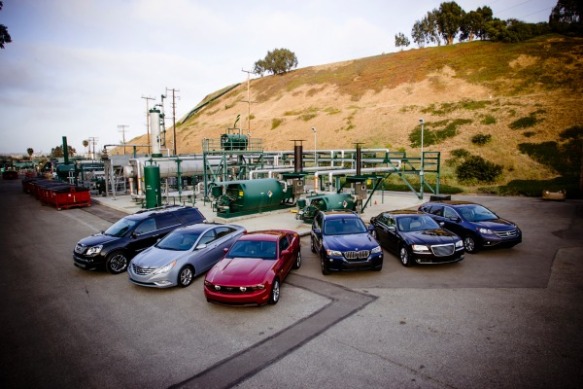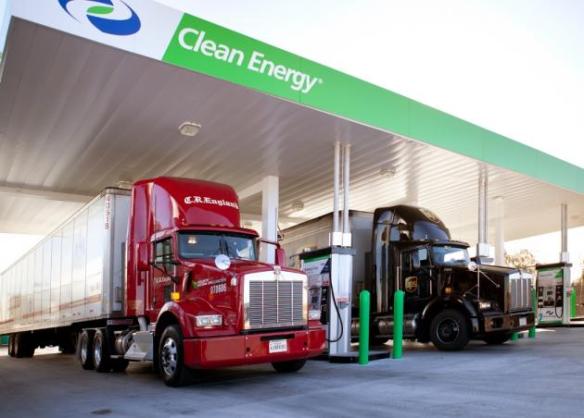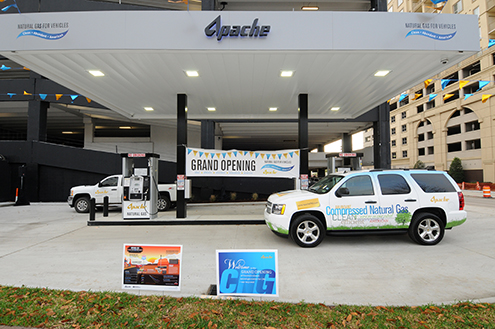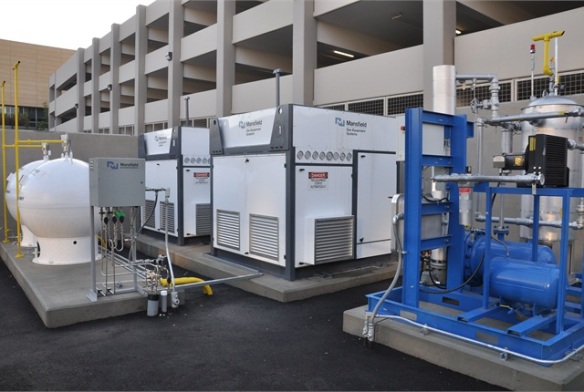Just the Facts
- Natural gas backers are launching a drive to persuade automakers to build compressed-natural-gas fueled cars and trucks.
- Six custom-built CNG vehicles are on display now in Washington, D.C., and builders say production versions would not cost much more than standard gasoline vehicles.
- Fuel can cost less than $1 a gallon-equivalent when produced at home.
WESTCHESTER, California — A natural gas lobbying group is launching a national effort today to persuade automakers and lawmakers to get off the gasoline and turn to natural gas as a significant fuel for new passenger vehicles in the U.S.
Natural gas advocates say that increased use of the suddenly plentiful fuel — made so by the opening of huge domestic reserves that can be exploited through an extraction process called hydraulic fracturing, or “fracking” — can help the country cut its dependence on imported oil while reducing greenhouse gas emissions and saving consumers millions of dollars in fuel costs.
But all that doesn’t matter if no one can afford the cars — of if they don’t offer the levels of performance, convenience and utility American buyers expect.
The big selling point of the Alliance program is that properly designed CNG-gasoline “bi-fuel” vehicles can be “no-compromise” cars and trucks that don’t sacrifice performance or storage space and don’t have exorbitant price tags, said Eric Noble, a consultant for the American Natural Gas Alliance-backed project.
Noble’s company, CarLab Inc., built four bi-fuel cars and SUVs that borrowed their operating philosophy from the new generation of plug-in hybrid-electric vehicles: use the alternative fuel for most daily driving chores but keep plenty of gasoline on board for extended trips and to avoid the danger of being stranded if the alternative fuel can’t be found.
To drive home those points the Alliance recently gave Edmunds.com and several other news organizations an advance look at six purpose-built bi-fuel cars, vans and trucks at a Southern California Gas Co. pumping facility on a hill overlooking a vast underground natural gas storage field just north of Los Angeles International Airport.
The same vehicles were rolled out in Washington, D.C., this week in a bid to wow legislators and people attending the annual ACT Expo.
“The cars in this program are the first step on the path to [mass] production,” said Barry Carr, an ANGA member and business development director for Landirenzo USA, the North American arm of a major Italian producer of CNG bi-fuel systems for automakers and aftermarket conversion companies.
Landirenzo, which built two cars for the ANGA demonstration, also makes systems for Fiat, General Motors, Volkswagen, Renault, Nissan and others in Europe, he said, and is doing aftermarket systems in the U.S. for Ford and GM trucks.
CNG could account for up to 80 percent of the average car owner’s annual mileage in a properly designed bi-fuel vehicle, Carr said. Natural gas fuel can cost well under a dollar a gallon when produced on home-based compression and pumping systems being developed by companies including Whirlpool.
Natural gas is a widely used passenger vehicle fuel in parts of Europe and South America and there are more than 15 million natural gas vehicles worldwide, said Kathryn Clay, executive director of the Drive Natural Gas Initiative and an ANGA member.
“But less than 1 percent of them are in the U.S., despite our big natural gas production,” she said.
Noble, whose Orange, California-based company built four of the six demonstration vehicles in the program, provided detailed cost sheets that showed the market price of every screw, fitting and supply line used in the conversions.
CNG costs vary from region to region based on the cost of the electricity used to compress the gas and the regional price of the gas itself. At retail pumps around the country the price is typically at least 50 cents a gallon less than gasoline and it can be half the price of gasoline in many areas.
A huge drawback of CNG passenger vehicles so far has been the high cost of the systems, which require expensive high-pressure fuel tanks; the loss of cargo or passenger space that’s given over to those large, cylindrical fuel tanks; and the lack of a nationwide CNG refueling system.
The system being pitched by ANGA tries to address all of those issues.
The average premium over MSRP for the all-gasoline versions of the four bi-fuel vehicles shown by CarLab was just under $2,900 for cars built in small commercial quantities of 20,000 units a year, and slightly less than under $1,900 for vehicles built in large volumes of 200,000 or more per year.
“The average payback period is 2.2 years for someone driving 12,000 miles a year with gasoline at $3.53 a gallon and CNG at $1.17” a gasoline-gallon equivalent, Noble said.
“That compares to 3.4 years for a Toyota Prius (at the same fuel costs), 7.4 years for a Nissan Leafelectric car and 34.4 years for a Chevrolet Volt” plug-in hybrid, he said. “This isn’t a technology with the promise that the price will come down in 10 years” he said of the natural gas conversions. “It’s cheap now.”
The costs Noble cited contrast sharply with the nearly $7,500 price premium Honda charges for the 2012 Civic Natural Gas — the only factory built CNG passenger car sold in the U.S. today.
The key difference is that the Honda is a dedicated CNG vehicle that can’t use any other fuel — and thus has a large and very expensive high-pressure fuel tank — while the alliance is promoting bi-fuel vehicles that don’t need substantial CNG tanks.
The four CarLab demonstrators — a Ford Mustang GT, a Hyundai Sonata sedan, a GMC Acadia large crossover SUV and a BMW X-3 small crossover — all are designed to travel 50 miles on CNG before switching over to gasoline.
The two vehicles prepared by Landirenzo — a Honda CR-V small crossover SUV and a Chrysler 300sedan — emphasized CNG use and thus had larger tanks for the pressurized fuel and correspondingly higher conversion costs that added $4,800 to the MSRP of each.
The computerized engine control unit in each of the demonstration vehicles decides which fuel to use for the best performance, but prioritizes CNG until that fuel is depleted and gasoline is all that’s left to burn.
The CarLab vehicles kept their stock gas tanks and added small CNG tanks, typically holding the energy equivalent of 2 to 4 gallons of gasoline, while keeping all of their original cargo space. The Landirenzo vehicles had 9-gallon-equivalent CNG tanks plus their stock gas tanks, adding almost 180 miles of CNG travel to their range but losing a substantial amount of cargo space — 75 percent in the Chrysler’s case.
All six vehicles maintained their stock horsepower and fuel economy levels with either fuel.
The idea in both cases, said Noble, is to “give people the cost savings of using CNG for most of their driving but enable the vehicles to seamlessly switch to gasoline when the CNG tank is empty. That way people can just keep on driving with no inconvenience. Long trips aren’t a problem. And there’s no problem if you forget to fill up with CNG overnight.”
Edmunds says: Sounds like a couple of interesting approaches. Is anyone in the car business listening?
This article was first published by Edmunds.com.











